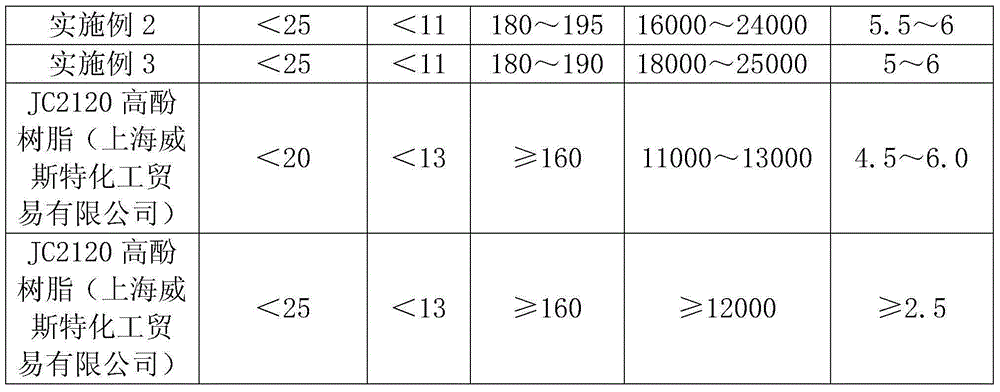Preparation method for rosin modified phenolic resin
A technology for modifying phenolic resin and rosin, which is applied in the field of preparation of modified rosin, can solve the problems of high viscosity and good solubility, and achieve the effects of high softening point, good solubility and low acid value.
- Summary
- Abstract
- Description
- Claims
- Application Information
AI Technical Summary
Problems solved by technology
Method used
Image
Examples
Embodiment 1
[0013] 1) Put rosin into the reaction kettle, raise the temperature to 180°C, add fumaric acid, the molar ratio of rosin to fumaric acid is 1:0.1, continue to heat up to 210°C and keep it warm for 1 hour to carry out the addition reaction;
[0014] 2) Add pentaerythritol and magnesium oxide to the reactor, the molar ratio of rosin to pentaerythritol is 1:1.1, cool down to 160°C, and add nonylphenol and p-tetraoctylphenol in a molar ratio of 1:1.05, Then continue to cool down to 130°C, then add paraformaldehyde at a ratio of phenolic molar ratio of 1:2.2, and keep warm at this temperature for 1 hour;
[0015] 3) Raise the temperature in the reactor to 260° C. and keep warm to carry out esterification reaction until the acid value is less than 25 mgKOH / g, and distill off low boilers under reduced pressure to obtain rosin-modified phenolic resin.
Embodiment 2
[0017] 1) Put rosin into the reaction kettle, raise the temperature to 180°C, add fumaric acid, the molar ratio of rosin to fumaric acid is 1:0.3, continue to heat up to 215°C and keep it warm for 1.5h to carry out the addition reaction;
[0018] 2) Add pentaerythritol and magnesium oxide to the reactor, the molar ratio of rosin to pentaerythritol is 1:1.3, cool down to 170°C, and add nonylphenol and p-tetraoctylphenol in a molar ratio of 1:1.08, Then continue to cool down to 140°C, then add paraformaldehyde at a ratio of phenol-formaldehyde molar ratio of 1:2.3, and keep warm at this temperature for 2 hours;
[0019] 3) Raise the temperature in the reactor to 270° C. and keep warm to carry out esterification reaction until the acid value is less than 25 mgKOH / g, and distill off low boilers under reduced pressure to obtain rosin-modified phenolic resin.
Embodiment 3
[0021] 1) Put rosin into the reaction kettle, raise the temperature to 180°C, add fumaric acid, the molar ratio of rosin to fumaric acid is 1:0.2, continue to heat up to 212°C and keep it warm for 1.2h to carry out the addition reaction;
[0022] 2) Add pentaerythritol and magnesium oxide to the reactor, the molar ratio of rosin to pentaerythritol is 1:1.2, cool down to 165°C, and add nonylphenol and p-tetraoctylphenol in a molar ratio of 1:1.06, Then continue to cool down to 135°C, then add paraformaldehyde at a ratio of phenol-formaldehyde molar ratio of 1:2.25, and keep warm at this temperature for 1.5h;
[0023] 3) Raise the temperature in the reactor to 265° C. and keep warm to carry out esterification reaction until the acid value is less than 25 mgKOH / g, and distill off low boilers under reduced pressure to obtain rosin-modified phenolic resin.
[0024] The resin of embodiment 1~3 is compared with existing resin as follows:
[0025]
[0026]
PUM
 Login to View More
Login to View More Abstract
Description
Claims
Application Information
 Login to View More
Login to View More - R&D
- Intellectual Property
- Life Sciences
- Materials
- Tech Scout
- Unparalleled Data Quality
- Higher Quality Content
- 60% Fewer Hallucinations
Browse by: Latest US Patents, China's latest patents, Technical Efficacy Thesaurus, Application Domain, Technology Topic, Popular Technical Reports.
© 2025 PatSnap. All rights reserved.Legal|Privacy policy|Modern Slavery Act Transparency Statement|Sitemap|About US| Contact US: help@patsnap.com


